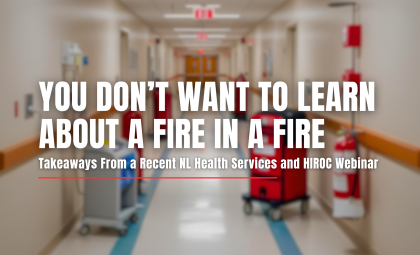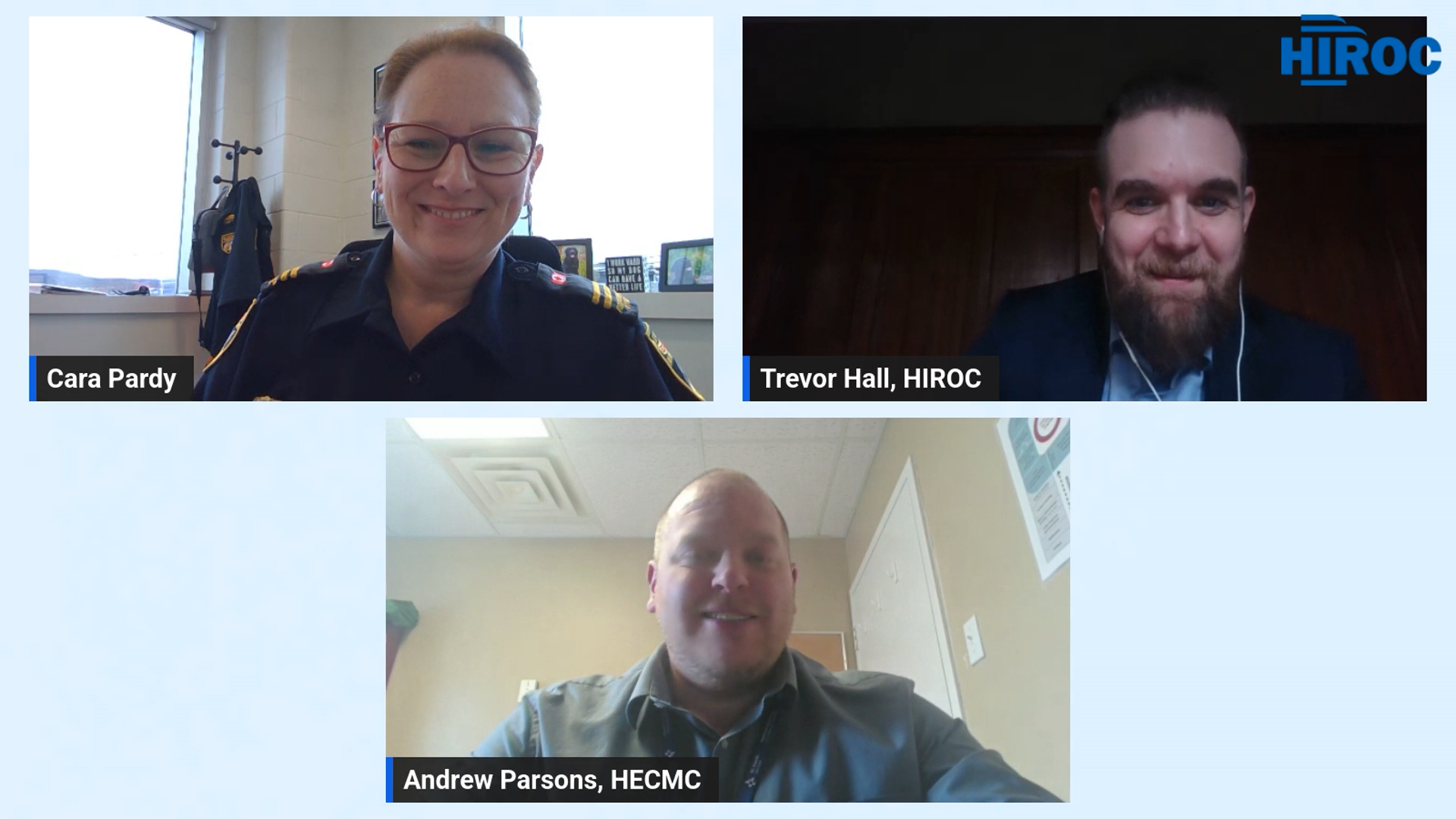You Don’t Want to Learn About a Fire in a Fire

With wildfire season underway in many parts of the country, being prepared for emergencies is now more important than ever.
That’s why during Emergency Preparedness Week (May 5-11), HIROC had the pleasure of partnering with NL Health Services on a webinar focused on fire safety in healthcare. This session aimed to equip staff and leadership in Newfoundland and Labrador with the knowledge and tools needed to navigate fire risks in their complex care environments.
HIROC’s Trevor Hall, Vice President of Healthcare Safety and Risk Management, opened the session and welcomed presenters: Andrew Parsons, Provincial HECM Coordinator with NL Health Services, and Captain Cara Pardy, fire captain with the St. John’s Regional Fire Department.
With so many great learnings for our friends from NL Health Services, we put together 10 top takeaways with the goal of sharing and scaling healthcare safety tips.
“You don’t want to learn about a fire in a fire,” said Hall. “Fire can spread in seconds, which is why it’s critical to understand your emergency plans now and be ready to act quickly.”
“If you’re unsure about your organization’s preparedness or need support reviewing hazards, don’t be uncertain alone. Reach out to your local fire department or HIROC. We’re here to help.”

Understanding Fire Safety in Healthcare Settings
Unlike other working environments, hospitals, long-term care homes, and other healthcare spaces are often large facilities where flammable chemicals are in use. Not to mention that life-sustaining equipment is always running, and patient evacuation can be complex and time-consuming. These conditions make both prevention and preparation critical.
“It’s important to know who your fire marshal is at your site,” said Parsons. “They will coordinate regular fire-life safety patrols and work with your fire wardens to identify and mitigate any hazards.”
During his presentation, Parsons referenced the National Fire Protection Association (NFPA) codes and Accreditation Canada’s standards. Parsons also highly recommends reviewing the role of local fire departments during Code Red activations and coordination between hospital teams and first responders.
Common Hazards and Best Practices
Captain Cara Pardy built on these themes by sharing photos of real-world common fire hazard examples that her team has encountered in healthcare settings, all of which can significantly hinder fire suppression efforts and evacuation procedures.
- Improper use of extension cords and power bars
- Improper storage of flammable liquids or chemicals
- Improper disposal of smoking materials or oily rags
- Obstructed fire safety/protection equipment such as fire alarms, smoke detectors, pull stations, sprinkler heads, and hose cabinets
- Cluttered office areas, hallways and emergency exits
- Breaches in a fire separation or firewall (i.e., holes in electrical room ceilings)
Captain Pardy underscored the importance of healthcare staff being proactive in fire safety by making it part of their day-to-day work. If seen, staff should take action to do things like close fire doors if they’re open, maintain clearances around fire equipment, and keep storage away from fire suppression systems.
Staff should also become familiar with two-stage fire alarm systems used in many healthcare settings, and understand what actions are required at each stage. They should also be aware of emergency code plans, evacuation routes, and designated muster points.
Key Takeaways
The following are a practical set of action items HIROC’s Subscribers across Canada can take to strengthen fire safety:
- Thoroughly review your facility’s emergency code plan and evacuation procedures
- Ensure health emergency management binders are current and accessible
- Learn about your site’s fire suppression systems
- Collaborate with your team to make fire safety a regular part of day-to-day work
- Review your site’s action card with your fire warden and identify any gaps
- Participate in fire drills and emergency preparedness exercises
- Ensure staff understand the RACE and PASS acronyms
- Reinforcing that every fire alarm should be treated as a real emergency, even drills
- Seek out fire safety training opportunities with local fire departments to build confidence and skills
- Identify and address potential fire hazards in your workplace with a fire marshal and local fire department
Fire safety is a shared responsibility. Please reach out to HIROC with any questions about fire safety in your organization and connect with your local fire department to schedule a check-in if you haven’t already.
“We at HIROC are so fortunate to be able to tap into the expertise of our Subscribers,” said HIROC’s CEO, Catherine Gaulton. “It’s for this reason that we value these learning opportunities, hearing directly from HIROC Subscribers, and sharing their knowledge and lessons learned widely across the Reciprocal – that’s the HIROC advantage.”
If you’re looking for resources, head to our resources page. And as always, reach out to [email protected] with any questions or to share what’s working at your organization.
A strong partnership and ongoing dialogue are key to keeping patients, staff, and facilities safe.
By Marc Aiello, Communications and Marketing Specialist